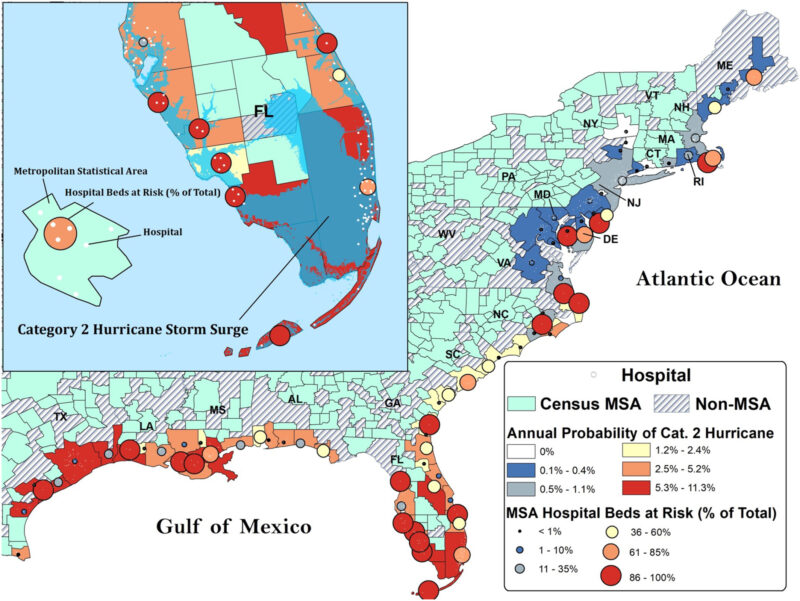New VA Facility Used as Model to Protect Them
BOSTON ― In late September, Hurricane Ian, a deadly Category 4 storm, caused widespread damage, flooding, loss of power and evacuations from hospitals and nursing homes across Cuba and the U.S. Southeast, especially Florida and South Carolina. With several months remaining in hurricane season, hospitals along the U.S. Atlantic and Gulf coasts must brace for the major healthcare system disruptions that accompany these destructive storms.
A new study published in the journal GeoHealth assessed hurricane risk to the United States hospital-based healthcare delivery using storm surge hazard maps from the Sea, Lake and Overland Surges from Hurricanes (SLOSH) model from the National Weather Service of the National Oceanic and Atmospheric Association. SLOSH is the operational storm surge model of the U.S. National Hurricane Center.1
“Our study published in GeoHealth is the first to systematically investigate flooding risk to nearly 700 U.S. hospitals on the Atlantic and Gulf Coasts from Category 1-4 hurricanes,” Aaron Bernstein, MD, MPH, told U.S. Medicine. Bernstein is the director of the Center for Climate, Health, and the Global Environment at the Harvard University T.H. Chan School of Public Health (Harvard Chan C-CHANGE) and a pediatrician at Boston Children’s Hospital.

Click to Enlarge: Annual predicted probability of storm landfall and percentage of beds at risk. Map of metropolitan statistical areas (MSAs) on the United States Atlantic and Gulf Coasts at risk of hurricane landfall. Shading indicates probability of landfall. Circles represent percent of beds at risk from a category 2 hurricane. Inset depicts focused area of Florida peninsula with hospital locations (white markers) and Sea, Lake and Overland Surges from Hurricane model predicted flooding area in blue. Source: GeoHealth
“The research from Harvard Chan C-CHANGE, PSE Health Energy and Boston University found that even relatively weak storms pose a serious flood risk to hospitals along the East Coast,” he pointed out.
The study used a VA facility as an example of what can be done to protect hospitals. In Louisiana, it noted, the new Southeast Louisiana Veterans Health Care Center, which replaced the VA Hospital and Charity Hospital in New Orleans after Hurricane Katrina, provides a model for how coastal hospitals and health systems can improve their hurricane resilience. The hospital facility was designed to remain operational for seven days, even if city utilities and infrastructure are compromised, and it features back-up fuel supplies, on-site sewage treatment facilities and sufficient accommodations for up to 1,000 staff and patients to shelter in place. “Critical mechanical and electrical equipment, as well as patient care areas, are located at least 20 feet above the 100 years floodplain,” the authors added.
About one-third of the 78 metro areas analyzed in the study have half or more of their hospitals at risk of flooding from a Category 2 storm. Sea level rise expected in this century increases the odds of hospital flooding by 22 percent, the study reported.
Northeast Also at Risk
“Surprisingly, we found that the most at-risk hospitals aren’t just in hurricane-prone areas like Florida, but also in the Northeast, including my hometown of Boston,” Bernstein wrote in an email. “Due to climate change, hurricanes are expected to grow stronger and move further north up the coast, putting hospitals at risk that haven’t previously had to deal with hurricane flooding before.”
Hurricanes and sea level rise can have devastating effects on healthcare delivery in these areas. Flooding from hurricanes not only damages hospital infrastructure as well as causes power outages, supply shortages and patient evacuations, but it also makes it difficult for patients, providers and staff to get to hospitals.
“As we saw with Hurricane Ian, storms have the potential to devastate health care infrastructure and disrupt patients’ ability to access care,” Bernstein explained. “Our study gives us a sense of which hospitals are most vulnerable on the Atlantic and Gulf Costs, so we can take action now to bolster our resilience to flooding and make plans that protect patient health when disasters strike.”
“In 18 of the metro areas we looked at, at least half of the roads within one mile of hospitals were at risk of flooding from a Category 2 storm. Even if a hospital can maintain operations and be resilient to flooding, if patients can’t get to the hospital, they still aren’t able to access the health care they need.”
Hospitals that haven’t yet had to deal with flooding from hurricanes may not be immune to future climate disasters, Bernstein added.
“Climate change is making storms stronger and pushing them to new areas that don’t have as much experience with major storms, and sea level rise due to climate change may increase hospital flooding 22 percent by the end of this century,” Bernstein wrote. “Health systems should make plans and build resilience now before disaster strikes.”
“Now that we have a better sense of which hospitals are at risk of flooding from hurricanes, we can take steps to avoid crises that other hospitals have had to endure by learning from their experience and creating plans that build on best practices. We can learn from hospitals that have already invested in resilience measures, like the Southeast Louisiana Veterans Health Care Center built in 2016.”
Surprise climate events, such as hurricanes, painfully expose issues that need to be addressed in our society, he added.
“They harm our most vulnerable people first; they allow health disparities to fester and make addressing other health challenges more difficult,” Bernstein explained. “We need to do all we can to stop the burning of fossil fuel, transition to clean energy, and help our health systems and communities grow stronger by building smarter and more resilient to climate change.”
- Tarabochia-Gast AT, Michanowicz DR, Bernstein AS. Flood Risk to Hospitals on the United States Atlantic and Gulf Coasts From Hurricanes and Sea Level Rise. Geohealth. 2022 Sep 29;6(10):e2022GH000651. doi: 10.1029/2022GH000651. PMID: 36203949; PMCID: PMC9521195.


